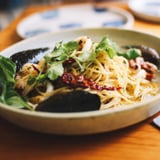mercredi 18 juillet 2018
Reheating Pasta and Rice Is the Weight-Loss Hack You've Always Wanted

Ever wish that you could enjoy pasta without the carbs and calories? Well, dreams apparently do come true. Turns out, you actually digest fewer cals and carbs when you eat leftover pasta, thanks to a process called retrogradation. You may not be able to enjoy your meal hot off the stove, but allowing pasta (and rice!) to cool down changes its structure into one that makes it healthier for us to consume. Let us break it down.
First, it's important to know what a resistant starch is. We've heard time and time again how bad carbs are for us, but that applies to refined carbohydrates like bread and pasta. Resistant starch is a type of fiber that's made up of carbs that resist digestion - hence its name - and makes your body work harder to convert it into energy. This causes your metabolism to fire up. Foods like beans and green bananas naturally contain these starches. But according to Erin Palinski-Wade, RD, CDE, author of Belly Fat Diet For Dummies, and consultant to Swisse Wellness, one way a resistant starch is created is during retrogradation, when cooked food is cooled.
"When starches are heated, they lose their original structure and when cooled, create a new one which forms the resistant starch," Erin told POPSUGAR. "Starches like white rice and pasta, when cooled after cooking, increase in resistant starch allowing fewer carbohydrates and calories to become digested."
If you're wondering how long you should let your food cool down, a study found 24 hours to be the most effective. Researchers compared freshly cooked white rice, cooked white rice that was cooled to room temperature for 10 hours, and cooked white rice that was cooled for 24 hours then reheated. The latter showed to have higher resistant starch and "significantly lowered glycemic response" in adults who participated in the clinical study.
Now you can feel less guilty about reheating those leftovers!










0 comments:
Enregistrer un commentaire